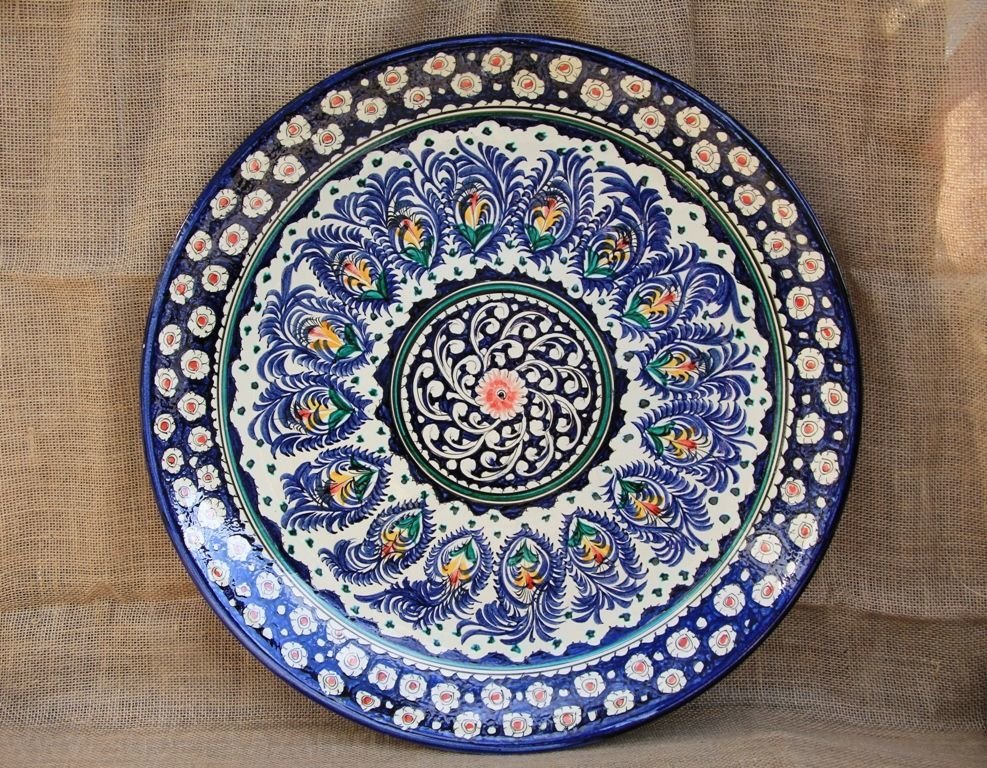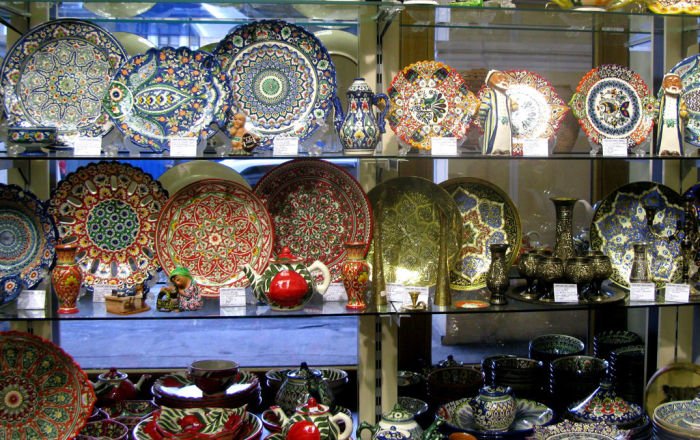Rishtan ceramics – all life in one plate
Ceramics is one of the oldest forms of art and over the years it has absorbed the traditions of various historical periods.
Since ancient times, Uzbekistan has been famous for first-class ceramics, not only beautiful, but also high-quality. In recent years, many fakes designed plates for tourists have appeared around the world, and only real masters of this craft know what real clay dishes should be like.

Rishtan is a city in the Ferghana region of Uzbekistan, which since ancient times has been famous for its masters in the manufacture of ceramics. Like all other schools, Rishtan has its own design features, a set of characters and colors. Rishtan ceramics can always be distinguished by the turquoise tones of products painted with bizarre patterns.

Rishtan ceramics are not just beautiful clay plates and jugs, they are also amulets for their owners. Each curl on the ornament carries a sacred meaning.
Each master in his work relies not only on his boundless imagination, but also on the tradition of a particular school, and if he brings something new, then only within the framework of the established style. Ceramics, according to the master, is generally an individual product, you can see a hundred lagans (large dishes for plov) identical in appearance, but each will have its own story. This attracts tourists who are looking for a twist.
You can become a real ceramist only if you really love to “mess with clay,” you put your heart into your work.
Secrets of Rishtan Ceramics
Rishtan ceramics serves as a talisman for its owners. The ornament, drawings and patterns on it carry a sacred meaning. The dot in the middle of each plate indicates the birth of a person. The following describes all the stages of his life: growth, education, work, marriage, the appearance of children, grandchildren. Even death, which does not mean the end of life, the masters see it as a continuation: in grandchildren, great-grandchildren, great-great-grandchildren. Each given stage is illustrated in its own way on a plate of rishtan. The patterns on the plates are never repeated, there are no two identical plates.

If you ever take a closer look at the patterns and see the characters you know, then you should know what they mean. So,
- Kumgan – a jug, a symbol of hospitality;
- Fish – a symbol of purity and wealth;
- Birds – a symbol of peace and freedom;
- Anor – pomegranate, a symbol of wealth, abundance and fertility;
- Bodom – almonds, means luck, happiness and wealth;
- Knives – a guard against evil

Stages of the production of ceramic dishes
The secrets of making dishes are passed on from father to son for many centuries.
- The selection of raw materials. Rishtan reddish clay – hoki surh (does not need preliminary processing and aging).
Glaze Components
- quartz – ok gosh;
- white quartz sand – ok kum.
Mineral dyes - Manganese – Muggle – dark purple and dark brown;
- ferruginous clay – jusha, malgash – yellow;
- louvard – lapis breeds – turquoise and ultramarine;
- copper – miss (waste from the production of Kokand coppersmiths)
Ishkor herb for making potash glaze.

- A mold of a form.
The potter during the manufacturing process transfers strength and energy, singing songs and prayers. Members of his family usually work in the workshop; in some, one or two apprentices. - Drying.
Depending on the type of product, the master dries it from 40 days to 1 year and covers it with engobe – a special composition of liquid clay to reveal a bright turquoise color after firing. - Firing.
The ceramics acquire the final form after firing (980-1000 degrees). Clay is completely sintered and hardens, and various coatings melt and solidify. - Painting.
The authors draw the plot of mural for Rishtan ceramics from nature, which is why it is so rich in floral ornaments. Its colors combine the blue of heaven, turquoise mountain rivers and flowering gardens. The master always enriches her with his imagination, giving each element a meaning. At the bottom of the product, the author puts his own brand. After painting, the master secondly burns the product.

Another name of big ceramic plate is “lagan”. In the manufacture of dishes, two types of ceramics are traditionally used: non-irrigated baked terracotta and glazed ceramics. The Uzbek lagan is a unique object, casting it’s giant size. The diameter of the lagan can reach up to 1 meter or more.
A handmade lagan with a diameter of 38 cm, artificially hand-painted by national ornament and considered as a unique object, which many people use as a souvenir or decoration, and it also can be used for its intended purpose. On the sides of the lagan there are ribbed waves that give even more uniqueness to this decor or use for dishes.

Do you want to know how to choose quality ceramics?
Firstly, sweep the ceramics by hand, the entire surface should be smooth, without bubbles, otherwise a chip may appear in this place.
Secondly, slightly click on the product, Rishtan ceramics has the ability to reproduce the sound of high quality porcelain. The louder the reproduced sound, the better are the dishes.
